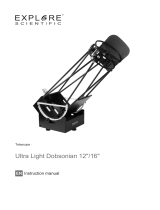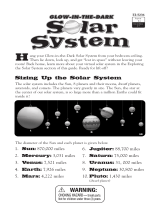
Explore Scientific Color Filter
What ist a color Filter for ? And do we really need it ?
Color Filters darken the light slightly, that reaches the eye or the sensor of the camera. This eliminates
for instance stronger transitions. The result is that your picture turns out with more contrast which
automatically shows more details.
Explore Scientific Filter 1.25" Light Red No.23A – part No. 0310271
The blue/blue green light is totally blocked. The contrast between the card and the lighter zones will
enormously increase. This is truly helpful when you watch Jupiter or Saturn. Or for mars, watching the
poles.
Explore Scientific Filter 1.25" / 2” Red No.25 – part No. 0310270 / 0310278
The blue/blue green light is totally blocked. The contrast between the card and the lighter zones will
enormously increase. This is truly helpful when you watch Jupiter or Saturn. Or for mars, watching the
poles.
Explore Scientific Filter 1.25" Dark Red No.29 – part No. 0310274
The blue/blue green light is totally blocked. The contrast between the card and the lighter zones will
enormously increase. This is truly helpful when you watch Jupiter or Saturn. Or for mars, watching the
poles. Starting with a telescope diameter of 10“ you can really use it effectively.
Explore Scientific Filter 1.25" / 2” Orange No.21 – part No. 0310273 / 0310279
This one really supports the detection of the dark areas on the planet Mars. The details of the clouds
of Saturn and Jupiter are also so much more visible through the Filter.
Explore Scientific Filter 1.25" Light Yellow No.8 – part No. 0310268
Watching the Moon surface through the filter, the contrasts will enormously increase. Same with planet
Mars. On the huge planet Jupiter, when using the filter, you can even see the contrasts between the
cloud-bands and a lot more details. Starting with a telescope diameter of 8“ and a clear sight, you
even get to see various details of Saturn. Minimum 2” aperture recommended.
Explore Scientific Filter 1.25" / 2” Yellow No.12 – part No. 0310267 / 0310277
Watching the Moon surface through the filter, the contrasts will enormously increase. Same with planet
Mars. On the huge planet Jupiter, when using the filter, you can even see the contrasts between the
cloud-bands and a lot more details. Starting with a telescope diameter of 8“ and a clear sight, you
even get to see various details of Saturn. Minimum 3,5” aperture recommended.

Explore Scientific Filter 1.25" Dark Yellow No.15 – part No. 0310266
Watching the Moon surface through the filter, the contrasts will enormously increase. Same with planet
Mars. On the huge planet Jupiter, when using the filter, you can even see the contrasts between the
cloud-bands and a lot more details. Starting with a telescope diameter of 8“ and a clear sight, you
even get to see various details of Saturn. Minimum 5” aperture recommended.
Explore Scientific Filter 1.25" Yellow-Green No.11 – part No. 0310269
Watching the Moon surface through the filter, the contrasts will enormously increase. Same with planet
Mars. On the huge planet Jupiter, when using the filter, you can even see the contrasts between the
cloud-bands and a lot more details. Starting with a telescope diameter of 8“ and a clear sight, you
even get to see various details of Saturn.
Explore Scientific Filter 1.25" Green No.56 – part No. 0310262
The green filter is to increase the contrasts enormously between the red and the blue regions of the
cloud structures on the gas planets Jupiter and Saturn. Seeing our Earth Moon through the green
filter, the contrasts of each ray crater become clearly more visible.
Explore Scientific Filter 1.25" / 2” Dark Green No.58A – part No. 0310261 / 0310275
The green filter is to increase the contrasts enormously between the red and the blue regions of the
cloud structures on the gas planets Jupiter and Saturn. Seeing our Earth Moon through the green
filter, the contrasts of each ray crater become clearly more visible. This filter should be used at an
aperture of 8“.
Explore Scientific Filter 1.25" Light Blue No.82A – part No. 0310265
The color of light blue really supports watching the high clouds on Mars. The contrast increases. The
dark red structures will be shown even darker, so this is the perfect filter for watching the big red
Flecks on the gas planet Jupiter. The rings of Saturn will be accentuated, the structures of the Venus
Atmosphere will be even finer.
Explore Scientific Filter 1.25" / 2” Blue No.80A – part No. 0310264 / 0310276
The color of light blue really supports watching the high clouds on Mars. The contrast increases. The
dark red structures will be shown even darker, so this is the perfect filter for watching the big red
Flecks on the gas planet Jupiter. The rings of Saturn will be accentuated, the structures of the Venus
Atmosphere will be even finer.
Explore Scientific Filter 1.25" Dark Blue No.38A – part No. 0310263
The color of light blue really supports watching the high clouds on Mars. The contrast increases. The
dark red structures will be shown even darker, so this is the perfect filter for watching the big red
Flecks on the gas planet Jupiter. The rings of Saturn will be accentuated, the structures of the Venus
Atmosphere will be even finer. Works well starting with a 10“ aperture.
Explore Scientific Filter 1.25" Violet No.47 – part No. 0310272
The purple filter is perfect for watching Venus. Seeing through it, the dark clouds of the Venus
atmosphere become even better visible. He also clears up the structures of the rings around Saturn.
Using big openings and having a clear sight this filter is also good for watching Merkur.
-
 1
1
-
 2
2
Bresser Filter Set 1 Moon & Planets from 50mm (2'') Owner's manual
- Type
- Owner's manual
Ask a question and I''ll find the answer in the document
Finding information in a document is now easier with AI
Related papers
Other documents
-
Orion STARBLAST 9814 User manual
-
 Explore Scientific 0116940 Owner's manual
Explore Scientific 0116940 Owner's manual
-
National Geographic NG90EQ User manual
-
 Educational Insights GeoSafari® Glow-in-the-Dark Solar System Product Instructions
Educational Insights GeoSafari® Glow-in-the-Dark Solar System Product Instructions
-
Meade ETX-70AT Junior User manual
-
Meade LXD55 User manual
-
Meade DS-114AT User manual
-
Orion #9007 SpaceProbe 130ST EQ Reflector Telescope User manual
-
Meade LightBridge Mini Owner's manual
-
Meade 60AZ-AR User manual



